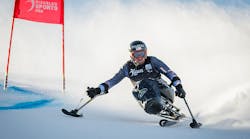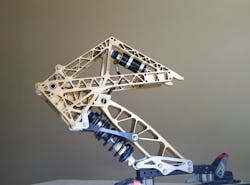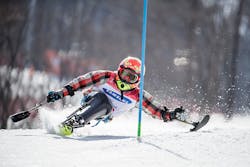The impetus for Joachim Grenestedt in designing new equipment for adaptive skiers was simple. A college instructor, he watched one of his students with physical limitations attempt skiing and noticed his student and many other adaptive skiers were using broken equipment.
“I believed we could design and manufacture a better sled,” Grenestedt said.
Building on his experience in designing land speed racers, boats and aircraft, Grenestedt and his wife, Channy Tokura, started a Pennsylvania company that designs and manufactures monoskis, in 2011. Now their equipment is used by everyone, from Paralympians to recreational skiers, and the company’s four styles of monoskis are the most technically innovative in the industry.
“What makes them different is their attention to detail,” said Chris Young, a long-time Paralympian who has been using DynAccess monoskis for seven years. “He’s got this idea that he’s going to be the premier monoski maker in the world. Channy is the best customer service representative I’ve come across for any adaptive equipment I might need. DynAccess has elevated our sport to the mainstream.”
What’s a Monoski?
A monoski consists of a bucket seat and a stiff and strong frame with suspension mounted to a single ski. DynAccess offers four models of monoskis, and they are designed to be more durable, adjustable, and responsive than any other monoski on the market. Their equipment works well for all levels of adaptive skiers, from beginners to professionals. Equipment can also be adjusted as a skier’s skills improve, and also have superior durability.
Monoskis are designed for people who have physical limitations with their lower extremities. The first monoskis were built in the 1950s, but the sport’s popularity has slowly increased. Popularity waned for a time as snowboarding became more popular, but now, with technological developments, more people are trying the sport. There are even monoskiing festivals in the United States and France.
Each monoski package includes a frame, racing shock, thermo-formed bucket seat with foam pads, adjustable chest, lap and thigh straps, an adjustable footrest, evacuation straps, and foot piece.
Grenestedt combined his interest in engineering faster equipment and skiing to build a better monoski. “I’d seen a lot of these adaptive skiing programs and it is truly amazing what some people can do,” Grenestedt said in an interview with Lehigh University. “Skiing is a high-adrenaline outdoor sport with lots of action, and I love it.”
What a Shock
All DynAccess models are equipped with Penske Racing shocks. The shock absorbers are specifically developed for monoski applications. All of the shocks are hand-built by Penske technicians to order from DynAccess, and they all undergo dyno-testing. “Paraplegic skiers can’t use their legs to absorb shocks, so the ski has to do the work,” Grenestedt said.
Penske shocks are most commonly used in fast-performance vehicles, but they are also used in military and defense vehicles. For the DynAccess monoskis, the shocks can be adjusted to work well for all levels of skiers.
The Hydra monoski model, for instance, includes a custom coil-over-shock, with either single or dual coil springs. Springs are selected based on body weight, ride style, personal preference, disability, and other factors. Heavy riders need stiffer springs than light riders. Softer springs are preferred for speed skiing events, while stiff springs are generally used in more technical events, such as slalom.
Penske is also based in Pennsylvania, near the DynAccess manufacturing plant. “They make the best shock absorbers on the market, hands down,” Grenestedt said.
In the research and development phase, Grenestedt met frequently with Penske officials and would frequently discuss shock absorbers. Grenestedt offered skiers a chance to ride on a prototype and returned to Penske with feedback about its performance. The Penske Pro Air, an 18 - 20 in. long aluminum shock absorber is used exclusively in DynAccess monoskis.
High-Performance Plastics
Besides the shock absorbers, key components in some DynAccess models are products manufactured by igus, a Germany-based manufacturer of motion plastics. The monoskis include flanged bearings from igus, which runs its North American operations out of Providence, R.I.
Perhaps the most essential feature of the igus bearings is their resistance to chemicals and moisture. The bearings, made with a material called iglide® T500, are frequently found in woodworking, aerospace engineering, plastic processing, and beverage technology. The bearings also offer excellent wear resistance through temperatures ranging from -148° to 482°F.
The material also has extremely high tensile strength and is one of igus’ most widely used bearings for solving highly technical issues. igus bearings are also widely utilized in the mountain biking industry, for example, in the pivot point where the suspension meets the frame. “We tried other components and they worked fine, but the igus products have worked better,” Grenestedt said. “They offer low wear, good strength, small size, and no corrosion at a good price.”
Proven Results
In 2015 and at age 53, Young became the oldest person to win a gold medal at the X Games in Aspen, Colorado. He was also an early adoptee of DynAcess products. He was paralyzed in a plane crash in 1982 while serving in the United States Coast Guard.
Tyler Walker won a silver medal for the United States in the 2018 Winter Paralympics in Pyeongchang, South Korea. Stephani Victor and Arly Velasquez, who represents Mexico, have also achieved international success using DynAccess products.
Adaptive skiers, particularly those who race, need sophisticated equipment to not only go fast but stay upright. One wrong move can result in dreadful physical consequences. The only thing that stands between Young and calamity on the slopes is his ski. “My life, literally, depends on the machine not breaking,” Young said. “Some runs, there are places where falling is simply not an option. If you fell, you could go off the cliff, and it’s the end.”
Most skiers understand the risks that they take, and technology and innovation are helping get more people rushing downhill and enjoying the mental and physical benefits associated with the sport, whatever their level of ability.
“Joachim is a skier, so he understands that sport and the quest for speed,” Young said. “The community got lucky that they decided to take on monoskiing as a company. It has certainly elevated the game all around the world by introducing more precise techniques and engineering. They’ve created a company ethos of building better, safer equipment, and in the end, it gives adaptive skiers a pretty good day on the slopes.”
Nicole Lang is the iglide® Product Manager for igus North America.












